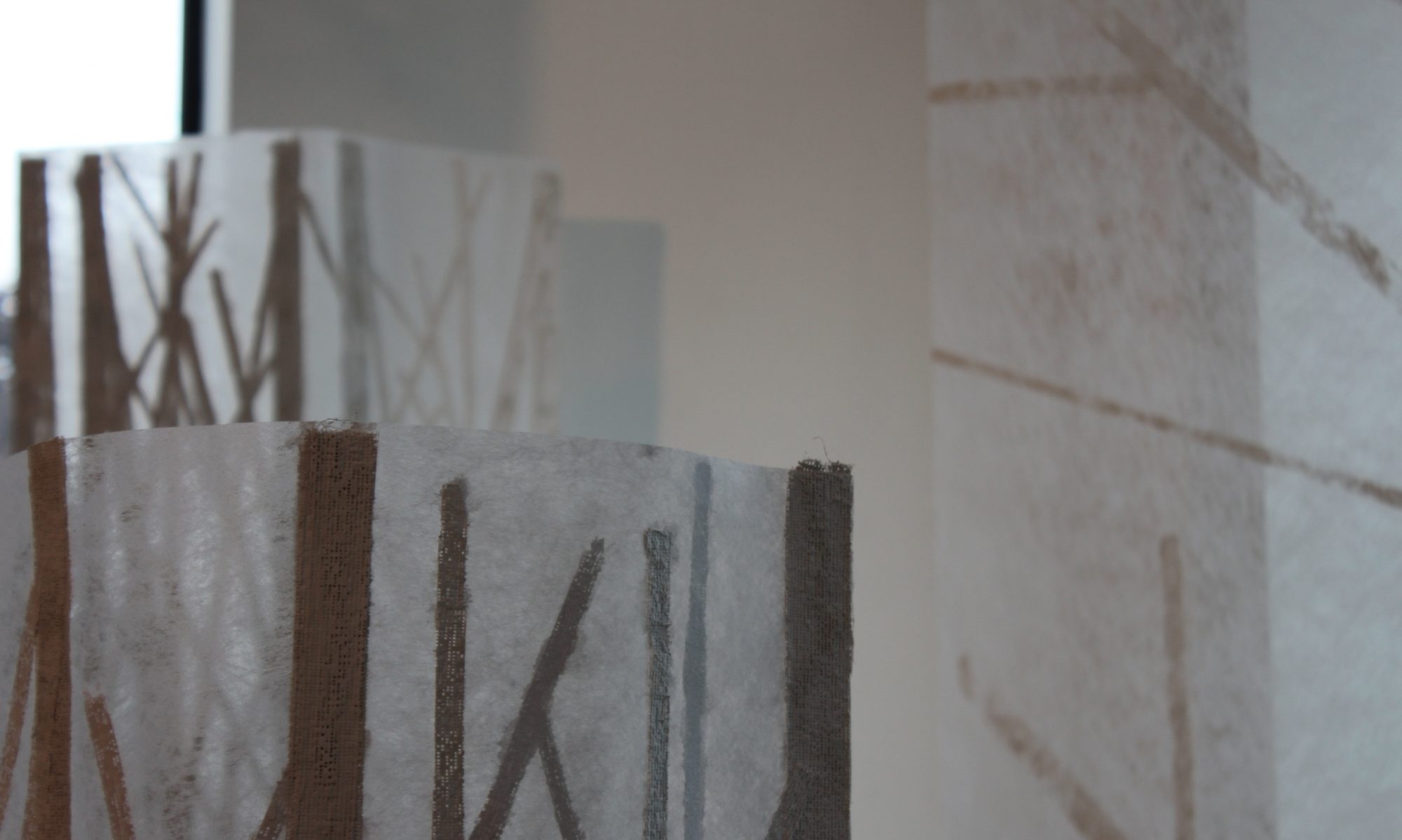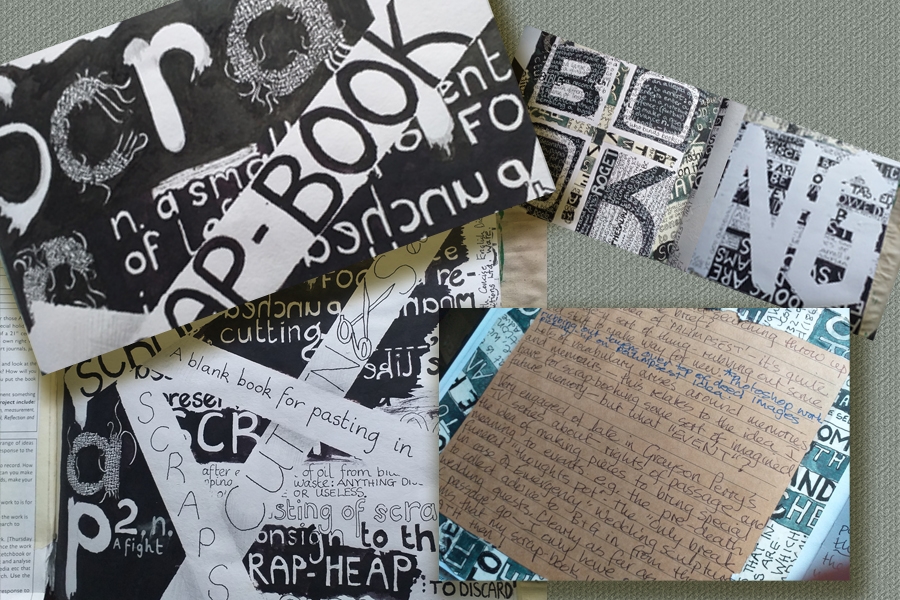Throughout this project it has been helpful to keep referring to the brief for guidance and direction regarding the objectives and outcomes it encompassed. I have found it a good organisational strategy to separate the recording of my process into a ‘making and doing ‘ category and a ‘what you have to do’ category. The latter helping me to keep focused on research, influences, and the technical requirements of the brief, while the former lays out the development of my ideas conceptually and through experiments with media, techniques and visual ideas developed in workshops. Also, I have drawn, scribbled, and stuck things into a physical sketchbook along the way. So, what have I achieved? In terms of the brief requiring ‘One sketchbook of ideas and processes AND a resolved ‘Scrap That’ piece’, I have met the brief.
Reading through the bullet point guidance for the project, I believe that I have satisfied relevant pointers within the context of my theme. I have included work developed in each workshop and have tried to select and refine pieces appropriate for inclusion in my resolved piece, according to the suggestions in the list regarding exploring different scales, media and techniques. For example, during the printmaking phase I used enlarging techniques to scale the photographs I had collected to the same proportions as each other, before drawing them onto the plates for cutting. When they were finished I had to produce small scale copies of the portraits to include in the final book. Looking at what I have produced, if I were to do it again I would re-make the embroidered and appliqued piece and create it to fit the box cover by design. I was determined to include that workshop piece in the final outcome and simply did not have time to re-do it within the time frame of this project so it more ‘decorates the box’ than ‘encases the lid’ it which is a pity. I set myself quite a challenge in terms of combining fabric, paper, print and ephemera within the book, a lot of skills, crafting and aesthetic processes have melded together and although I am very proud of the results, the ‘finish’ could be improved by making each leaf separately (not as the continuous folded zig-zag) and then finding a neat binding method rather than, as happened, having to stitch through several layers of the Zig-zag all at once … keeping all the stitching neat has proved very difficult.
Considering the question of context; as it says in the brief, ‘Where does your work sit in the real world? Who are you creating the work for? Is it personal?’ My piece is very personal and has been created as perhaps, an heirloom or gift for loved ones that I may pre-decease so that they know my love for them, my thoughts about them and what I hope to happen to me when I die. It has proven to be quite an emotional project for me, laden with nostalgia, reminiscing about treasured moments with people who I have lost or even, never knew but feel connected to. It has made me think quite a lot about, and more deeply respect and appreciate many of the interests and talents that I have which, I owe to and or share with loved ones mentioned in my book. There is my Grandfather who inspired me as a gardener and always encouraged a love of academic learning; my father’s bequests were I think as an artist, educator and lover of landscapes and geologies, as a musician and a community activist. My maternal Grandmother was an inspiration to me as a needle-woman and seamstress among many other things – she was down to earth, with an excellent sense of humour and the widest open door to the warmest hospitality you could imagine. These people are very affectionately missed in my life but seem to have walked with me throughout the last six weeks. I never knew my paternal grandmother Martha, she died of pneumonia when she was 28, my father was almost a year old at the time. He proposed to my mother years later when (aged 28) he was recovering in hospital – from pneumonia – she said he was delirious and declined. He asked her again of course, when he got better, and she said yes. I contracted pneumonia just after my 28th birthday ….. does there seem to be a pattern/connection here?……… Stories told of Martha are all in the superlative – she was a feminist, a milliner- running a business with her sisters, and the first female Methodist lay preacher in the area where she lived. While I was head of R.E. during my teaching career, I read some of the philosophical texts that she used to study. It is edifying to consider her access to them and reflective writings based on them that she accomplished with very little formal education in her back-ground. I have always been full of admiration for her and named my daughter after her as a result. I am going the reserve comment here about my living family included in the book – except to say that I love them dearly.
As an expression of all of this, I think my book is akin to the spirit in which Watanabe created ”The Diary Of a Sparrow’ in honour of her father and as a bridge across time from old, traditional, Japanese language, life-style and culture into a modern expression of those values. It is also, a major influence structurally for my piece. Other primary research that I feel very much influenced by, was the Shearer collagraph of ‘Hawkstone Park Follies’. I spent ages looking at it to help me understand more about how to get the maximum tonal range possible out of the boards. I think the portrait series reflects how my skills developed in this sense from the first – of Martha to the last of my daughter. The whole premise for my book, I owe to Grayson Perry’s TV series which is both primary and secondary source material. It made me think about rites of passage and the way we celebrate them with culturally specific artefacts and events. It made me think back to my dissertation research for my B.Ed. and the reading I did about perception of cultural boundaries and the symbolic construction of community (Cohen. etc) and, I was reminded of how surprised I was when, years ago, I was on an exchange visit to Finland and resided with a family recently bereaved of the father/husband of the family, to find how forthright they were about death. One of the first things the family did to welcome me into their home (and I suspected that in the equivalent situation in Britain the bereaved family would have withdrawn from hosting an exchange student!) was to share the ‘funeral photograph album’ with me. I was to discover that this is a common practice there. Since then, rites and practices around death have always fascinated me. Thank you Grayson, for stimulating these thoughts and setting me off on the journey of expressing my ideas in this ‘Scrap That’ book.

